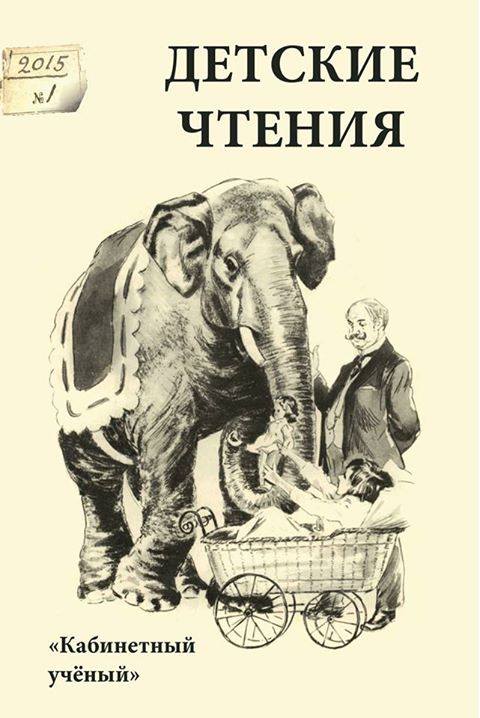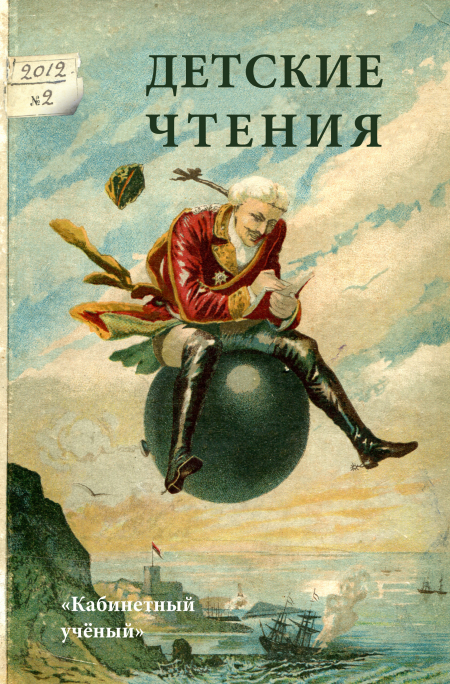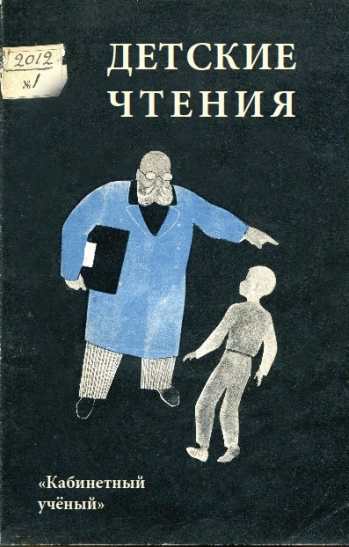Archives - Page 3
-

Vol. 7 No. 1 (2015)
In the seventh issue of "Children's reading," we continue to publish the materials of the international conference "Children's literature as a territory of conflict: texts, persons, institutions", which took place in the IRLI in June 2014. They formed the basis of the "Research" section. Heroes-orphans in children's literature, reflecting the social crisis of the beginning and end of the Soviet era (O. Bukhina, A. Lana), heroes-cannibals in the books of K. Collodi, S. Marshak, K. Chukovsky, A. Tolstoy and other famous authors, reflecting the adult fears of authors and readers (V. Vyugin), stories about the death of a child in the moralizing literature of the 18th century. (I. Sergienko), addressees of conflict situations derived in "Deniski's stories" by V. Dragunsky (O. Mikhailov), conflict situations in stories as a way to attract adolescents to the Orthodox Church (V. Zubareva) - this is a wide range of problems considered by the authors of publications. In the "Archive" section, we continue to publish little-known or forgotten texts related to the study of children's literature, interesting as examples of literary criticism and literary criticism of their time.
-

Vol. 6 No. 2 (2014)
The main focus of the 6th volume of “Children’s Readings” is on the evaluation of children’s literature as a territory of conflicts of a different kind. The authors of the articles attempted to address the following questions: What was the nature of institutional conflicts at different stages of children’s literature development? Who are/were formal and informal participants of this process, and what is/was the nature of their conflicts? Several articles address the nature of interactions between traditional and innovative forms employed by children’s literature; the authors revisit such traditional binary oppositions as dream versus reality, love versus hatred, “us” versus “them”, and past versus present. Among the important issues tackled by this volume’s participants are the aesthetic shifts within multiple genres of children’s literature, innovations in critical vocabulary employed in children’s literary criticism today, and changing gender and plurality concepts within different narrative forms.
-

Vol. 5 No. 1 (2014)
The 5th issue of "Children's Readings" is devoted to the formation of the literary canon, teaching literature at school, and the place of the classics in modern reading. Writers, critics, bibliographers, teachers of literature, and propagandists of reading answer the questions of our Questionnaire and discuss the practice of supporting reading (new textbooks and exhibitions, holding festivals, scientific research, fairs, training of teachers). The researchers' publications cover a wide temporal and thematic range: from pre-revolutionary anthologies (A. Kostin) and teaching literature in school in the 1930s. (E. Ponomarev), to the works of Oleg Grigoriev (A. Gubaidulin) and Ekaterina Murasheva (L. Rudov). The section "Reviews" presents the reactions of researchers to the materials of the Bologna Book Fair (E. Kazakova) and the events "Week of Children and Youth Books" (A. Dimyanenko).
-

Vol. 4 No. 2 (2013)
The current issue of "Children's Readings" is devoted to contemporary children's literature, genres of mass literature, and mass culture in general. An article by the authoritative American researcher Jack Zipes about the work of W. Disney acquaints readers with Western approaches to the analysis of works addressed to a children's audience. The articles of the "Research" block reflect the whole spectrum of literary approaches to the object of study: an academic interpretation of the work of a modern writer for children, the history of vampire literature and the reasons for its popularity among readers, a study of the graphic novel (comics) genre, the genesis of the Slavic fantasy genre and the mechanisms of constructing ideologemes in modern mass culture, a functional analysis of fanfiction, balancing on the borderline between literary creativity, subcultural practices, and graphomania. The dominance of mass cult topics in the issue is largely due to the fact that the beginning of the study of genres of mass literature addressed to children and adolescents in Russian literary criticism was laid not so long ago and is now in a phase of active development, largely shaping the scientific mainstream in the field of studying children's literature.
-

Vol. 3 No. 1 (2013)
The third issue of Children's Readings is devoted to the correlation between children's literature and ideology. The authors of the issue, leafing through Soviet children's books, try to answer the questions arising from these institutions' relationship. What restrictions do genre forms impose on ideological postulates: for example, how is local history writing embedded in the patriotic state discourse and, at the same time, in the avant-garde projects of legitimizing the child-writer? What is the genesis of the Soviet heroic models of behavior presented in children's literature? In what artistic forms were the boundaries of heroic and everyday behavior established? Are these forms specific for the Soviet period? How do ideas about the so-called universal human values - friendship, love, heroic deeds vary in certain periods? The presented studies, in our opinion, demonstrate that the research of the evolution of social and pedagogical ideas embodied in children's literature, the typology of the heroic, the genesis of ethical principles, the influence of the adult literary tradition on the children's, allows us to clarify something in the Russian children's literature of the 20th century.
-

Vol. 2 No. 2 (2012)
We devoted the second issue of "Children's Readings" to highlighting the problems of constructing the concept of children's literature in higher education courses and the process of university teaching. Irina Arzamastseva, the author of one of the authoritative textbooks on children's literature, reflects on this topic. Many of her judgments reflect the well-established Russian concept of children's literature and, at the same time, open up new problem areas of the concept of "children's classic". It is fundamental for us that the republication of the works of the significant researchers of children's literature N.V. Chekhov and E.P. Privalova allows us to think not only about the relevance of their searches after almost a hundred years. The republishing of the work of N.V. Chekhov (a classics of Russian children's literary criticism) demonstrates how far we have gone in understanding the phenomenon of children's literature, its boundaries, and functions. The study by E.P. Privalova is an example of a thorough analysis of the history of the entry of a literary work into the circle of children's reading. The second issue ends with a review of the round table "How to write the history of Soviet literature?"
-

Vol. 1 No. 1 (2012)
The first issue brought to your attention is collected from the works of the members of the editorial board, dedicated to those directions that are close to the compilers: children's literature of the 1920s, the influence of government institutions on children's literature, verse analysis of poetry for children, children's topics about adults literature, mass genres of children's literature, bibliographic descriptions of publications about children's literature. We decided that this is a good way to introduce ourselves to our readers. Researchers from Yekaterinburg, Nizhny Tagil, and St. Petersburg (M. Litovskaya, S. Maslinskaya, A. Sadrieva, A. Senkina, I. Sergienko) joined forces to create the "Children's Readings" project. We tried to build the almanac so that the "academic" part in it would coexist with literary criticism and informational and bibliographic ones. One of the tasks that we are pursuing is to collect old small-circulation publications that are of scientific interest today.






